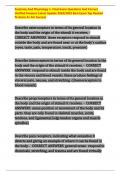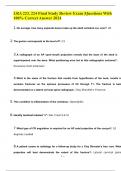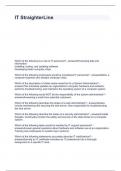Anatomy And Physiology 1- Final Exam Questions And Correct
Verified Answers Latest Update 2024/2025 Best Exam Top Ranked
To Score A+ For Success
Describe exteroceptors in terms of its general location in
the body and the origin of the stimuli it receives. -
CORRECT ANSWERS these receptors respond to stimuli
outside the body and are found near or at the body's surface
(eyes, taste, pain, temperature, touch, pressure)
Describe interoceptors in terms of its general location in the
body and the origin of the stimuli it receives. - CORRECT
ANSWERS respond to stimuli inside the body and are found
in the viscera and blood vessels. these produce feelings of
visceral pain, nausea, and stretching. (chemoreceptors in
blood vessels)
Describe proprioceptors in terms of its general location in
the body and the origin of stimuli it receives. - CORRECT
ANSWERS sense position or movement of the body and its
parts. they are only found in skeletal muscles, joints,
tendons, and ligaments(Golgi tendon organs and muscle
spindles)
Describe pain receptors, indicating what sensation it
detects and giving an example of where it can be found in
the body. - CORRECT ANSWERS general sense- respond to
chemicals, stretching, and trauma and are found virtually
,Anatomy And Physiology 1- Final Exam Questions And Correct
Verified Answers Latest Update 2024/2025 Best Exam Top Ranked
To Score A+ For Success
anywhere in the body that pain can occur (tissues, mucosa,
muscles, joints, gut. Not found in brain and similar organs.
Un-encapsulated, free nerve endings, distributed
throughout the body.
Propose how knowledge of the anatomy of cranial nerve
nuclei can be used to help pinpoint damage to particular
regions of the brain stem - CORRECT ANSWERS Different
parts of the brainstem are associated with different cranial
nerves. For example, the last 4 cranial nerves exit the
medulla oblongata. Problems with the last 4 cranial nerves
could indicate damage in the medulla and so forth.
Describe general senses in terms of its general location in
the body and the origin of the stimuli it receives:
exteroceptors, interoceptors, proprioceptors. - CORRECT
ANSWERS (somesthetic) sense touch, pressure, stretch,
heat, cold, pain, blood pressure, and blood composition.
Distributed all throughout the body: in the skin, muscles,
tendons, joint capsules, viscera. Can be
encapsulated(meissner, pacinian, krause, end bulbs) or
unecapsulated(nociceptors, temperature receptors, hair
receptor, Merkel disc.)
Describe special senses in terms of its general location in
the body and the origin of the stimuli it receives
,Anatomy And Physiology 1- Final Exam Questions And Correct
Verified Answers Latest Update 2024/2025 Best Exam Top Ranked
To Score A+ For Success
exteroceptors, interoceptors, proprioceptors. - CORRECT
ANSWERS sense taste, smell, vision, hearing, equilibrium.
Distribution is limited to the head and they are innervated
by the cranial nerves.
Describe temperature receptors, indicating what sensation
it detects and giving an example of where it can be found in
the body. - CORRECT ANSWERS general sense- respond to
either cold or hot stimuli. Un-encapsulated, free nerve
endings, distributed throughout the body.
Describe mechanoreceptors, indicating what sensation it
detects and giving an example of where it can be found in
the body. - CORRECT ANSWERS (including proprioceptors
and baroreceptors/pressoreceptors)
proprioceptors are stimulated by stretch (muscle spindles
and Golji tendon organs)in muscles and tendons.
Pressoreceptors(baroreceptors) can be found in blood
vessels and lungs (sense/monitor blood pressure changes
or extension of lungs)
Describe chemoreceptors, indicating what sensation it
detects and giving an example of where it can be found in
, Anatomy And Physiology 1- Final Exam Questions And Correct
Verified Answers Latest Update 2024/2025 Best Exam Top Ranked
To Score A+ For Success
the body. - CORRECT ANSWERS general and special sense-
detect chemicals for smell, taste, and blood composition.
Describe photoreceptors, indicating what sensation it
detects and giving an example of where it can be found in
the body. - CORRECT ANSWERS special sense- visual
receptors located in the eye(cones and rods)
Identify the location and structure of taste buds. -
CORRECT ANSWERS The taste buds are located on the
tongue (mostly), mucosa of cheeks, pharynx, and epiglottis
of larynx and consist of 50-100 epithelial cells:
gustatory (taste) cells. The gustatory cells have apical
microvilli (gustatory hairs) that are located int he taste
pores and a sensory fiber connection at the base of the cell.
supporting cells
basal cells
chemoreceptor
Explain how dissolved chemicals activate gustatory
receptors. - CORRECT ANSWERS Molecules must dissolve
in saliva and diffuse into the taste pore to contact gustatory
hairs of epithelial cells for sensory transduction.






